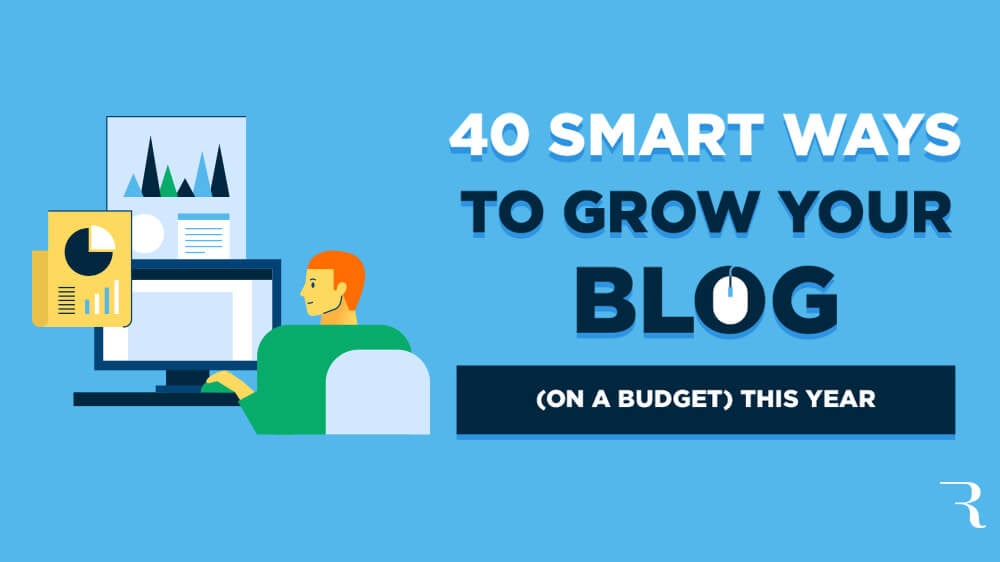Now, before you can fully focus on these strategies to grow a blog however, you’ll of course need to have started a blog in the first place.
If you haven’t already done that, then head over to my step-by-step tutorial on starting a blog and pick it up here once you’re ready to grow a blog. If you’ve already gotten your blog off the ground and are ready to start implementing proven strategies to grow your audience this year, then let’s dive right in.
40 Ways How to Grow a Blog Quickly (on a Budget) in 2024
- Create a well-researched editorial calendar
- Collect email subscribers and engage them
- Develop a content ecosystem for your blog
- Optimize your onsite SEO
- Target long-tail keywords
- Know where your audience spends time online
- Use paid advertising to experiment
- Take advantage of Pinterest
- Drive more traffic from your email marketing
- Find the right websites to guest post on
- Treat Quora as a goldmine of new readers
- Compile impactful expert roundups
- Co-host webinars
- Get interviewed on podcasts
- Launch a virtual summit
- Notify every person (and brand) you mention on your blog
- Create highly shareable images
- Make sharing your blog content easy
- Target the most active readers and sharers
- Diversify your content delivery mediums
- Slideshare as a powerful source of traffic
- Join active communities in your blogging niche
- Make sure your blog content is readable
- Monitor social media for mentions of your blog
- Build a community on Twitter
- Give back to your blog readers (and make money while doing it)
- Teach online courses for your blog readers
- Regularly ask your blog audience questions
- Make commenting as easy as possible on your blog
- Pack your blog with social proof
- Take advantage of chatbots
- Make your blog’s email newsletter shine
- Place lead magnets everywhere
- Offer hyper-relevant content upgrades
- Target exiting readers on your blog
- Create an online quiz
- Know your analytics data like the back of your hand
- Never stop A/B testing on your blog
- Automate & outsource with tools and contractors
- Continually experiment
Disclosure: Please note that some of the links below are affiliate links, and at no additional cost to you, I’ll earn a commission. Know that I only recommend products and services I’ve personally used and stand behind. When you use one of my affiliate links, the company compensates me, which helps me run this blog and keep all of my in-depth content free of charge for readers (like you).
Ready to Start Your Blog Today?


Check out my ultimate guide How to Start a Blog (on the Side) that’s been featured on Forbes, Inc and Entrepreneur.
One of the most common questions I get from readers who’ve just hit publish on their first blog posts is… ok, so now where is everyone?
As much as I’d like to tell you that building a successful blog is as simple as writing a great blog post or two, kicking back, and watching a flood of readers come flying in, the truth is that growing a blog is a bit more nuanced than that—it’ll take time, repetition and the willingness to experiment.
Use My Free Keyword Research Tool


Try my free AI-Powered Keyword Tool to get dozens of research-backed ideas for keywords & topics to write about on your blog today.
Quickly, before we move into breaking down all of my best ways to grow a blog, let’s define what I mean when I use the term growing a blog.
I’m not just talking about increasing the number of readers on your blog (driving traffic). More importantly, growing a blog is also about building your email list and helping you to make money from your blog. To me, growing a successful blog encompasses each of the following:
- Driving more traffic to your blog
- Growing your email list
- Increasing your revenue
- Expanding your influence and authority
Getting more readers for your writing is all well and good, but I want you to have more than just a cool blog that people check out once and go away forever. I want you to have a blog that actively contributes to your financial independence and freedom.
And that’s why this guide to growing a blog touches on each core stage of the blogging journey. The strategies I’m sharing with you today are the culmination of my 8+ years of trial and error growing my blog to 500,000+ monthly readers and often more than $50,000/mo in side income. These are proven tactics that I still put into practice myself—and cost little more than your time, hard work, and a touch of creativity.
Without further delay, let’s get into my best strategies for how to grow a blog in 2024.
1. Create a well-researched editorial calendar


The backbone of every successful content marketing strategy and I cannot emphasize this enough, is the editorial calendar.
As we all know by now, the fundamental pillar of any great content marketing strategy is your ability to produce high-quality content at a consistent rate. Increasingly, that’s what the major search engines (like Google) are rewarding, so it’s an important tenant to learning how to grow your blog.
In order to find your target audience (and bring them to your blog), you’ll need to be able to produce content that they find valuable. To keep those readers, you need to be able to create, develop, and publish that valuable content on a regular basis.
While this sounds relatively simple on the surface, even the best bloggers in the world will often struggle to meet this seemingly innocuous requirement.
Too often, bloggers take an ad-hoc approach to producing content. While this strategy might work for a while, it will inevitably lead to problems and stall out efforts to grow a blog—such as eventually running out of creative steam and not knowing which blog post ideas to pursue next, losing sight of your overall content marketing strategy, or missing deadlines and opportunities for promotion.
Without an editorial calendar, you’re never quite able to look beyond today and tomorrow. And how are you ever going to be able to grow a blog if you never get the chance to move beyond the short term?
A well-structured editorial calendar solves all of those problems by keeping your content organized, focused on your audience, and constantly flowing. Believe me when I say that your editorial calendar (or lack thereof) will be the one thing that makes or breaks your blog’s ability to grow.
Thankfully, I’ve spent the better part of a decade perfecting my editorial calendar template—both to manage content as I grow my own blog, and in growing the blogs of the world’s top startups like LinkedIn, Google, Zendesk, Adobe and more. You can grab my template for free right here:
Free Download: My Editorial Calendar Template
2. Collect email subscribers and engage them


Every online business lives or dies by the size and engagement of its email list.
If you’re already getting readers but don’t make an effort to collect their email addresses, it’s going to be difficult for you to grow your blog in the long run.
Next to your blog, your email list is going to be the most important asset you have in your marketing arsenal to grow your blog—in terms of traffic and revenue.
For one thing, you actually own your email list. By building an email list of engaged fans, you can worry a whole lot less about Google or Facebook suddenly changing their algorithms one day and finding yourself without an audience overnight. It’s one of the most long-term, sustainable ways to grow your blog and bring back repeat readers.
Email is not only the best way to consistently bring visitors and readers back to your blog—it’ll also be your primary method for reaching out and communicating with your audience on a personal level. Even something as simple as a newsletter that provides updates on your latest content and what you’re working on will go a long way towards building that sense of know, like, and trust that your audience has with you.
Start exploring different tactics to grow your email list, such as lead magnets, pop-ups, and content upgrades (don’t worry, we’ll be getting into these a little later). Make sure you’re also managing your email list with the right blogging tools like ConvertKit (or evaluate the best of the best in my comparison of ConvertKit vs AWeber vs Mailchimp).
3. Develop a content ecosystem for your blog


While your blog shouldn’t strive to be everything to everyone all at once, it does need to be a place that your target audience can rely upon as the ultimate authority on a specific topic. And to achieve that, you need to create a content ecosystem in order to really grow your blog.
Everything you publish on your blog needs to relate back to something else that you’ve previously published—creating a web of related content that satisfies your readers’ needs and answers their most pressing questions.
On a practical level, what this means is that instead of sending your readers to an external site whenever you want to link to a more comprehensive resource on a topic, you can instead direct them to a different post on your blog.
This way, as soon as someone finds a piece of your content just by clicking on most of the links in your article, they’ll continue to stay on your blog and within your sphere of influence—which is why this is such a great foundational strategy to grow a blog.
To achieve this, you’ll want to adopt a hub-and-spoke model with your content.


The hub-and-spoke model is essentially a visual graph of your content ecosystem, like mine, right here.
At the center—or hub—you have your content pillars. These are your authority pieces, your evergreen content, and the in-depth mega guides that cover your major topics. Here on my blog, there are authority pieces on topics that cover every major segment of what my audience is learning about—like how to start a blog, the best web hosting plans for bloggers, the best affiliate programs for them to join when they’re ready to monetize their blogs and more.
From there, you create your—spokes—the pieces of content that are designed to drive more traffic back to your major hub guides.
Whenever you’re publishing a new piece of content, whether that’s on your own blog or someone else’s in a guest blog post, you want to link back and build authority for your central hub pieces. Not only will this help grow your blog in the long run, but it’ll greatly improve your blog’s SEO and help you gain a better understanding of how all your content ties together within your content ecosystem.
4. Optimize your onsite SEO


In today’s fast-paced environment, any blogger worth their salt should at least have a basic understanding of how to optimize a blog post for SEO.
Before you even begin to write a new blog post, do some basic keyword research to adhere to smart blog SEO strategies and figure out which keywords you should be targeting. You can do this by taking advantage of any number of keyword research tools out there, including Ahrefs, SEMRush, Twinword Ideas, and Google Keyword Planner.
From there, it’s just a matter of adhering to best practices for SEO optimization and making sure to include your keywords in your blog headlines, your URLs, image file names, and so on.
Need Catchy Blog Title Ideas?
Try my free AI-Powered Blog Title Generator Tool to get dozens of SEO-friendly headline ideas to make your blog posts stand out today.
While there’s certainly a lot more you can dive into with SEO, having the basics down will make it a lot easier for you to rank your content on Google.
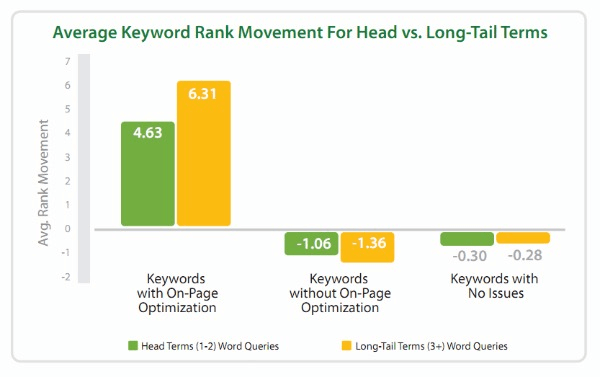

To help you out, make sure to check out Yoast SEO if you’re running a WordPress blog.
It’s one of the most useful WordPress plugins that helps you to optimize the SEO of an individual blog post by testing your page for you and giving suggestions on how you can improve your onsite SEO—helping to grow your blog in a meaningful way.
5. Target long-tail keywords


One way to increase your Domain Authority and start generating more organic search traffic to your blog is to focus on long-tail keywords, especially if you’re just starting out.
While those short keyword phrases may look bright and shiny with their promise of hundreds of thousands of monthly searches, don’t be fooled by pursuing those straight out the gate. I can guarantee you that thousands, if not millions, of other blogs are attempting to rank for the same keywords—and a good chunk of them probably have a much higher domain authority than your blog.
Here’s an example to illustrate the difference between high-volume keyword phrases and long-tail ones:
- High-volume keyword phrase: email marketing
- Long-tail keyword phrase: email marketing for food bloggers or email marketing for startups
Instead of chasing after the most competitive search terms, shift your focus to long-tail keywords that are more niche-specific… so instead of writing a review of free blogging sites or writing a range of Bluehost reviews (with a lot of competition), you could instead start by targeting more niche search terms like “free portfolio sites for photographers” if a segment of your audience includes photographers.
These are keywords, or phrases, that generally have three or more words. While long-tail keywords have a lower search volume, they more than adequately make up for it in the ROI they can bring you in your efforts to grow your blog.
For even more specifics on how to nail your blog’s SEO and choose smart keyword phrases, tune into these episodes on my podcast:
6. Know where your audience spends time online


Let’s take a moment to think about the best places for you to promote your content (and thus grow your blog).
A common mistake I see with new bloggers is adopting a “spray-and-pray” approach when it comes to their social promotion. Promoting their new blog posts on every social media platform that they can think of. This kind of approach is highly ineffective—both in the fact that it’s a huge waste of your time and resources and that you’ll probably only end up with a disappointing ROI at best.
Put yourself in your audience’s shoes.
Think about what sites they like to visit, what kind of forums they might participate in, and which social media platforms they’re most likely to use. For example, LinkedIn might be your best bet if you have a very business-oriented blog, whereas if you have a mom blog, then Pinterest is probably the platform for you.
Don’t waste your time sharing content with an audience that doesn’t care. Instead, make it easier for your target audience to find you by figuring out how to get your content directly in front of them.
7. Use paid advertising to experiment


While we’re all about growing your blog traffic as organically as possible, I can’t deny the power of paid advertising as a way to experiment and learn.
If you’re lucky, you may even dial in a paid acquisition process that’ll help increase your blog’s overall exposure and conversion rates.
When you have a particularly high-converting page that you want to promote, take advantage of a Facebook ads campaign, Pinterest promotion, or Google AdWords to drive your target audience to that page and see which channels convert best.
8. Take advantage of Pinterest
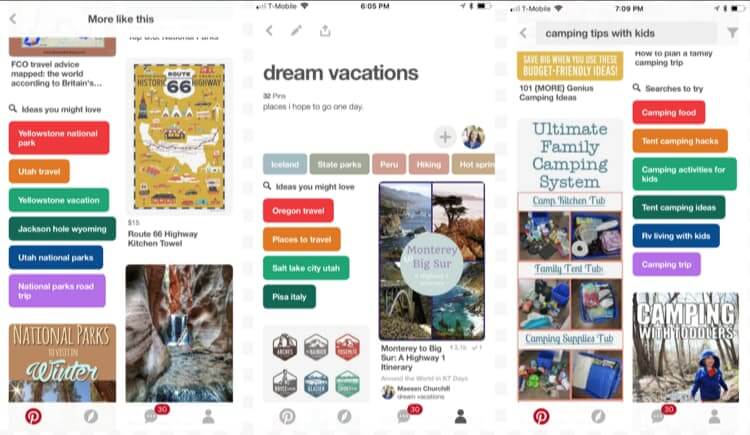

Pinterest is very quickly becoming the secret weapon for bloggers looking to grow their blogs.
Often mistaken as a place for middle-aged housewives to share their latest recipes and DIY projects, you’ll be surprised at how powerful Pinterest can be to help grow your blog once you look past its surface.
Pinterest outshines its other social media cousins in its ability to generate a higher ROI, with one study finding that marketing on Pinterest produces 380% greater sales than your average digital marketing campaign. As if that wasn’t enough, the average Pinterest post is also 100 times sharable than your average tweet, and according to Tailwind, the average lifespan of a pin is at least one week, whereas content on Facebook lasts only 80 minutes.
Take advantage of Pinterest by creating eye-catching images of your blog posts, and share it to relevant boards and groups to grow your blog.
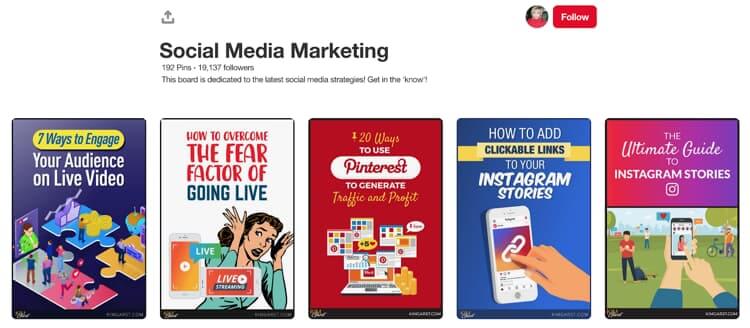

Just look at how social media marketer Kim Garst uses her Pinterest board to share her latest posts and grow her blog in a visually appealing manner.
9. Drive more traffic from your email marketing


While most bloggers already know the power of email marketing and the importance of capping off marketing messages with a strong call-to-action, chances are you’re still missing out on a prime piece of email real estate for driving traffic toward your blog.
Your email signature.
Forget about using your email signature as a basic means to share your quick contact information.
Instead, start utilizing your corporate email signature as a way to actively grow your blog and promote your latest content. Whether you’re emailing a client or a potential lead, including a link to your blog posts is a great way to spread your brand awareness and show off your knowledge and expertise.
You can even take it a step further by creating a strong CTA for your best-performing (or highest-converting) content as a way to generate direct conversions.


For example, check out how the email signature above contains a CTA for recipients to join a free webinar—an activity that many bloggers employ to grow a blog.
10. Find the right websites to guest post on


One of the best ways to quickly grow your blog by improving your level of domain authority (and influence) is guest blogging on other people’s sites.
The best part about guest blogging is that it allows you to share your expertise with a pre-existing community of engaged readers while simultaneously establishing your authority amongst your target audience.
Try thinking of your guest posts as sampler material for your own (more in-depth) blog content. By regularly publishing high-quality posts on a variety of other authoritative sites, you’ll be able to attract the attention of your target audience and have them craving more.
The key to effective guest blogging, though, is making sure you’re finding the right places to guest post. It won’t help much if you’re posting on sites that none of your target readers would ever think to visit—that’s not exactly helping to grow your blog.
Start by creating a list of sites that you know that your audience trusts, and see if you can get in touch with their editor. If you’re brand new to blogging, then start with other writers in the niche you blog about, that are a little more established—don’t immediately rush to inquire about writing for sites like Forbes, Inc and Entrepreneur.
It might take a while to get some traction, and you’ll certainly have no shortage of rejections, but if you’re sending strong cold emails, taking the time to write a blog post outline that’s geared toward their readers, then as your network and portfolio grow, you’ll find that it gets easier and easier to write for bigger and better blogs.
11. Treat Quora as a goldmine of new readers
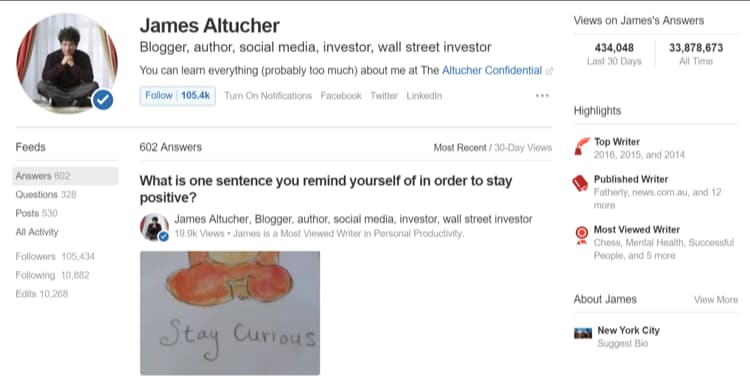

Quora is a question-and-answer forum that allows anyone to respond to questions across a wide variety of topics and users. Unlike its somewhat deformed and red-headed cousin Yahoo Answers, Quora possesses a highly-moderated community that generally provides questions and answers of much higher quality than other similar sites.
A tactic that I’ve used successfully to grow my blog is to find genuine questions that are relevant to my niche (blogging) and spend a meaningful amount of time delivering in-depth answers to those people.
Within my answer, I’ll typically add a call-to-action to a relevant blog post that I’ve published in the past, which is a great strategy to grow your blog with incremental referral traffic as you build a reputation.
By continuously posting well-researched answers on Quora, I’ve been able to build up my authority within my niche, as well as grow the authority for my blog.
12. Compile impactful expert roundups


For an easy way to create valuable content, network with influencers, and grow your blog by boosting credibility and expertise at the same time—look no further than compiling expert roundup posts.
With an expert roundup post (like both my compilation of the best blogging advice and the best business advice), what you’re essentially doing is crowdsourcing an article from a variety of influencers in your industry. By simply associating your own name with other authorities and influencers within your blog niche, you’re signaling to your audience that you also have similar levels of expertise.
While you can often compile an article by utilizing existing quotes found online, I like to send as many personalized cold emails as possible to key influencers when I’m writing a roundup post so that I can include some fresh advice not found elsewhere.
Not only does this give your blog post extra credibility, but if you can get any of these influencers to share the post after it goes live, that’s a strong vehicle by which you can grow your blog.
As an alternative tactic to grow your blog, you can also make it well-known that you’d love to participate in other blogger’s roundup articles. Dive into your network. Find social groups with other bloggers and actively share your advice when others have questions.
With this approach, instead of laboring on a 5,000-word article, you can write a short (but still valuable) answer and get mentioned alongside other big names within your niche.
13. Co-host webinars


Another way to consistently grow your blog by getting in front of an engaged audience and demonstrating your expertise—is to co-host a webinar with a well-known brand, more established blogger or company in your industry.
Many brands and bloggers currently run webinars as a part of their content marketing strategy, and most of them are always looking for creative ways to bring more value to their audience by having an expert to share valuable knowledge.
14. Get interviewed on podcasts


This is a tactic I’ve used for several years as a way to grow my blog—and it’s always brought me great results.
Even if you don’t have your own podcast (like mine), that doesn’t mean you can’t still take advantage of both the growing popularity of podcasts and the need of podcast hosts to have on interesting guests.
There are more and more shows springing up every day, and all of them are hungry to provide unique and valuable content for their audience. What that means for you is that there are practically endless opportunities for you to get interviewed by a podcast—provided, of course, that you have something worthwhile to say.
But don’t wait around for podcasts to notice you and your story. Get a head start on this strategy to grow your blog by reaching out to a handful of podcast hosts every week and seeing who’d be interested in bringing you onto their show.
15. Launch a virtual summit


While nothing beats the ability to connect and communicate with people face-to-face, that doesn’t mean you can’t achieve similar results (and grow your blog at the same time) through video interviews.
Virtual summits are fast becoming one of the most popular ways for influencers to network with other influencers in their space and get their brand in front of an engaged audience.
While hosting a virtual summit requires no small amount of work, it’s a tactic that can pay off hugely in the sheer amount of leads and exposure it can bring you. If you’re interested in learning how to host your own successful virtual summit as a vehicle for growing your blog, make sure to check out my step-by-step guide on how I created a virtual summit that reached over 20,000 people in just 60 days.
16. Notify every person (and brand) you mention on your blog


One way to greatly increase your chances of having your content distributed is to mention as many influencers as tastefully possible within your blog content. This is one of the most low-effort, effective strategies I’ve used to grow my blog for free over the years—it takes nothing more than your time.
The mention could be anything from including a quote by an influencer, to using their story as a case study, or simply linking back to one of their articles as an additional resource. The purpose is to build a meaningful relationship by providing value (in the form of a link) first.
As long as it’s contextual and there’s a good reason for you to mention them, you have yourself a great excuse to then cold email the influencer and ask them if your article is fit to share with their audience. Don’t forget to make it as easy as possible for them to share (by providing them with an easy copy or a link to an existing post that they can re-share).
Plus, even if they don’t end up sharing your content, this is still a great opportunity for you to network with influencers, get on their radar, and plant the seeds for what could become a larger relationship over time.
17. Create highly shareable images


One of the very basics of making your content as shareable as possible (and thus growing your blog traffic) is to include shareable images within your blog post. By a quirk of human psychology, we humans are predominantly visual creatures that are far more likely to respond to pictures and videos than we are to only chunks of text.
Use tools like Visme and Canva to create social media-ready images of your blog content.
This is something I regularly do for all my articles, guides, courses, and podcast episodes to make them more eye-catching and, consequently, more likely to get people to click through when they see my content being shared elsewhere online:
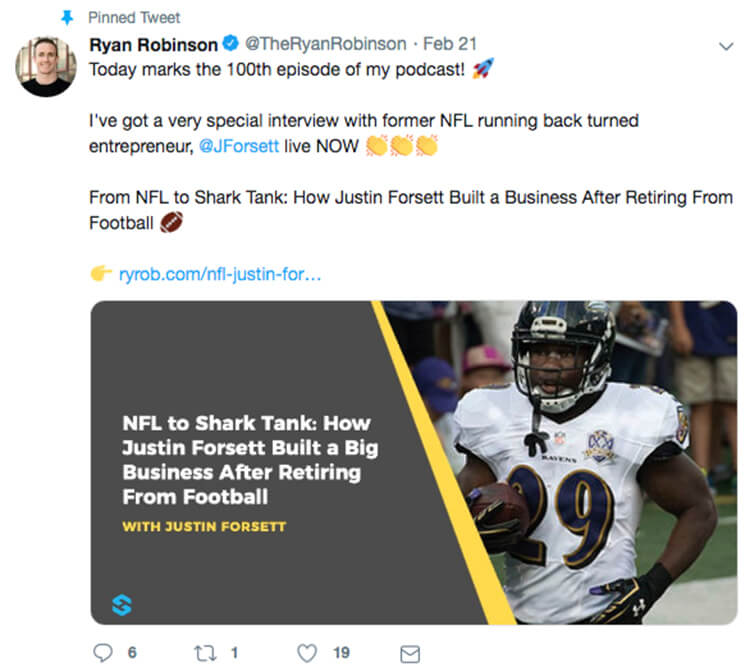

Kick your strategy on how to grow your blog up a notch by creating graphics specific to supporting sections within your individual blog posts. This can be something like a simple graph that visually represents a fact or statistic you just mentioned, or for the more artistically inclined, you can even design a mini cartoon or comic strip like this example over on the Plan.io blog—ideally something that matches the aesthetics of your existing blog layout.
Not only does using high-quality images within your blog content make your post more readable by breaking up large chunks of text, but it’ll also make your entire article a lot more engaging to read and far more likely to be shared.
18. Make sharing your blog content easy


The more effort it takes for someone to share your content, the less likely they are to share it.
This might seem to be a no-brainer, but there are a lot of blogs out there that don’t seem to have realized this yet—and are consequently missing out on crucial opportunities. If you want to grow your blog, share your content as painless and easy as possible for your readers.
Take advantage of tools like ClickToTweet, where you can pre-prepare tweets for your audience; all they need to do is click the text, and it’ll automatically share your article for them, like so:
Other simple things you can do to increase your content’s share-ability and grow your blog are to include social media sharing buttons throughout your content and suggest which hashtags your audience can use.
19. Target the most active readers and sharers


There are influencers out there with millions of followers who haven’t created a single word of original content.
But they’ve managed to amass a large following because their followers can always rely on them to share the latest and best content within their niche—and these influential aggregators are a huge opportunity to tap into as a way to grow your blog.
One of my favorite tactics to get my content out there is to identify who those influencers are and then ask them (nicely) to share one of my blog posts that could be relevant to their audience.
Using a tool like BuzzSumo, I’m able to find Twitter users who have a large number of followers and an audience likely to retweet the content (thus discovering even more people).
From there, all I have to do is send them a tweet or drop them a short email to let them know that I think they’d really enjoy my latest blog post, give them a compelling (genuine) reason why—and let them decide if it’s a good fit to share with their community.
20. Diversify your content delivery mediums


Believe it or not, not everyone consumes content in the exact same way.
Some people enjoy reading long-form articles (hello there!), while others might prefer watching a video or listening to a podcast. The great news is that you don’t need to come up with an entirely new topic, or even create any more content, to take advantage of these different content types as a vehicle for how to grow your blog.
As the name suggests, diversifying your content delivery is all about taking a single blog post and reworking it so that the same information can be expressed in a different way.
For example, if you’ve already written an exhaustive long-form article on something, consider turning that article into a pre-recorded webinar, embeddable video, or podcast episode as well. Or, if your article is heavy with facts and figures like my guide on how to start a blog, it could be well spun into an infographic.
One very important thing to keep in mind before you start diversifying your content is examining who your ideal customer profile is. There’s no point turning your blog post into mini-articles on Instagram if your audience doesn’t even use Instagram. If they do use Instagram, however, consider creative ways you can employ things like Instagram automation tools to better scale your results on the platform without investing too much time as you experiment and learn.
Take a moment to think about what kind of content your audience likes to consume, and focus your efforts on those specific types of content that stand a chance of helping to grow your blog.
21. Slideshare as a powerful source of traffic
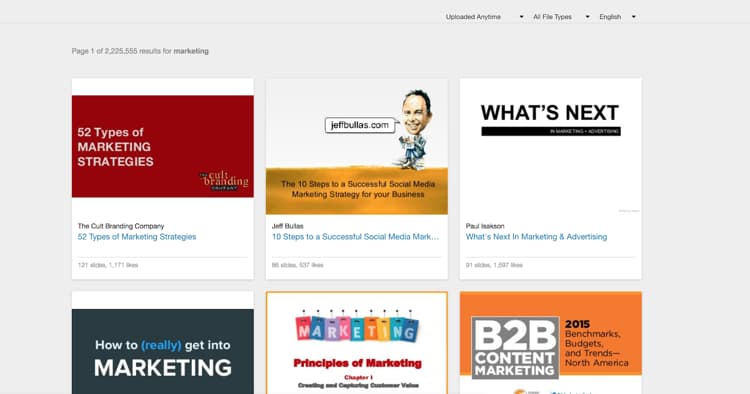

For those of you who may be unaware, Slideshare is a presentation-sharing platform (now owned by LinkedIn) that also happens to be one hell of a powerful traffic source.
When it comes to multiplying and repurposing your content, Slideshare is an easy way to lengthen the lifecycle of your blog posts and increase the exposure you’re able to get for an individual article—all you need to do is use a presentation maker tool to whip up a more visually appealing slideshow-style representation of your content and publish to Slideshare.
While this tactic might not be as effective for bloggers whose audience doesn’t spend a lot of time on LinkedIn, this same principle of turning your blog post into a simple PowerPoint presentation is still applicable to any blogger, no matter what niche you’re in.
Sharing your slide deck on social networks like Pinterest, Instagram as an IG story, or Twitter can be just as effective as a tool to grow your blog—if your audience is active on those social networks.
22. Join active communities in your blogging niche


No blog exists in a vacuum. If you’ve picked a niche to blog about with some popularity—then you’re really in luck.
While we might have romantic ideas of going it alone learning how to grow your blog without ever needing help from others, the reality is that there are literally thousands—if not millions—of blogging communities out there filled with other bloggers who are more than happy to share your content with their own audience.
Some great blogging communities to join include GrowthHackers, Product Hunt, Triberr, BlogEngage, and DoSplash.
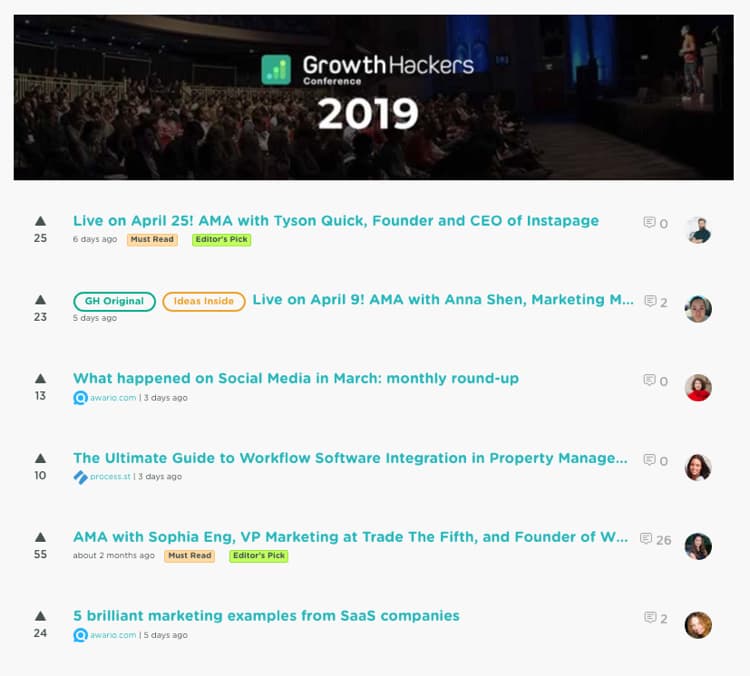

Depending on your niche, some communities will work better than others, but rest assured that in any one of those blogging communities you’ll find no shortage of opportunities to network, build relationships and grow your blog through amplified content sharing.
23. Make sure your blog content is readable


If you’ve ever seen Disney’s Aladdin, you’ll probably be familiar with the phrase “a diamond in the rough.”
There’s certainly a thrill in the romantic notion of putting in the effort to look past the surface and finding diamond beneath. But, in today’s world, where the average attention span for a human is, quite literally, shorter than a goldfish, you need to shine from the get-go if you want to grow your blog.
At the end of the day, it doesn’t matter how valuable the information in your blog is if no one can even be bothered to easily read it in the first place.
Take a step back from your blog and try putting yourself in the discerning shoes of your reader. Objectively, ask yourself questions such as whether or not your blog’s design is too cluttered, if you could use some images or videos to help break up the text, or if the way you’re writing might come across as overly complicated.
24. Monitor social media for mentions of your blog


Something that many bloggers overlook when they’re just starting out learning how to grow a blog is the “social” aspect of social media.
Social media is more than just a place for you to promote your blog content—it’s also a space where you can interact and communicate with your readers in an informal and personal way. Ultimately, the strength of your relationships with your readers will often dictate how likely they are to invite new readers over to your content.
The trick to playing an active part in that conversation is social media monitoring.
Make use of tools like Mention and Buffer Reply to get notified whenever someone mentions your brand (or the name of your blog) online. You can use social media monitoring to do anything from sending a personal thank you message any time someone shares your content unasked to gaining insight into what your readers are like or even as a way to resolve customer service issues before they can escalate—thus proving a very useful way to grow a blog over time.
25. Build a community on Twitter


With 245 million daily active users, Twitter is undoubtedly one of (if not the) best social media platforms for engaging with your audience and growing your blog readership.
You can engage with your readers on Twitter by regularly responding to any tweets that mention you and your blog and also by starting your own public conversations with your readers.
For example, starting a hashtag chat can be a great way to center a conversation around a specific theme or topic with your readers while also having anyone who participates in that discussion feel like they’re a part of your community—as well as having the option to invite others into the chat.
26. Give back to your blog readers (and make money while doing it)


More than just a way to make money as a blogger, affiliate marketing also presents bloggers with a unique opportunity to further nurture that sense of trust and loyalty with your audience.
When it comes to learning how to grow a blog by providing value to your audience, one of the most helpful things you can do is to direct them to products and services you know they’ll love.
Any time a reader takes your advice and has a positive experience with a product that you’ve promoted on your blog, they will feel rewarded and grateful for having placed their trust in you. It’s a small thing, but it goes a long way in further developing that relationship you have with your reader.
For myself, not only does affiliate marketing make up a large chunk of my blog income, but it also gives me a chance to give back to my community. Through affiliate marketing, I can demonstrate how in-tune I am with my audience’s needs and challenges, and I can reward their loyalty with discounted offers for things I know they’ll find helpful, while also increasing my own passive income at the same time. For example, in my guide about taxes for bloggers, I recommend a couple of extremely useful tax and finance-related tools that I personally use to better manage my blog business plan and printable blog planner resources.
27. Teach online courses for your blog readers


Most articles will talk about how online courses are a great way to generate passive income, but one critical element we often overlook is its ability to deepen the relationship you have with your audience.
From the get-go, teaching an online course immediately sets you up as an authority and expert on whatever it is you’re teaching. Anytime someone signs up to your online course, they actively acknowledge that they respect and trust your expertise, which is always a great foundation to build a relationship upon.
With an online course, you can dive deeper than you normally would into a particular topic and all its intricacies, as evidenced during my interview with Adda Birnir of Skillcrush.
Short of doing one-on-one consulting, an online course is probably the most engaging and personal way you can grow a blog and communicate your knowledge to your audience. By regularly engaging with your students, answering their questions, and sharing advice, you can turn every single one who takes your course into a loyal fan.
28. Regularly ask your blog audience questions


As I mentioned earlier, in order to grow a blog, you must be able to consistently provide value to your audience.
The only way to achieve that is to be intimately familiar with who they are and what they care about.
In the latest blogging statistics, marketers often stress the importance of knowing your audience’s demographics. While that information is certainly helpful, just knowing where your audience lives, their gender, or their level of education doesn’t provide any real insight into what makes them tick.
The only way to truly gain insight into your audience is to go directly to the source and ask them yourself.
By regularly asking your audience questions—whether via a tweet or customer survey—you’ll be able to gain a more complete understanding of what their pain points are, the kinds of solutions they’re looking for and the best way you can address their challenges. This’ll provide valuable insights about new avenues to grow a blog that benefits both you and your readers.
As an added bonus, while regularly questioning your audience is an effective way to keep them engaged, it also shows that you care about what they have to say and that you’re willing to speak with them, not just to them.
29. Make commenting as easy as possible on your blog


If you want your readers to keep coming back, then you need to make it as easy as possible for them to engage with you—and that means making it as easy as possible for readers to comment on your blog posts.
One of the most undervalued pieces of real estate on any website is the blog comment section (where I have over 6,000 combined comments on my posts). One of the reasons you chose to learn how to make a website in the first place was to connect with people, right?
Much like your email list, you actually own your blog comment section, and you don’t need to rely on other platforms in order to build a community around your brand. By creating a thriving comment section for every one of your blog posts, you’ll be able to converse, swap ideas, and engage with your audience in a way that isn’t possible through other mediums.
Another benefit with encouraging blog comments, is that it gives new readers immediate social proof that you have a post that’s worth reading. And it certainly also doesn’t hurt that your blog gets that extra little kick of SEO juice anytime someone mentions your target keywords in their comment.
Consider removing friction points, such as requiring readers to fill in captchas or forcing them to register before they can comment. While you might be making it harder for spammers to get through, you’re also definitely making it harder for your audience to engage with you.
30. Pack your blog with social proof


Humans are naturally social creatures. When confronted by the unknown, we typically look to others for advice and confirmation before even attempting to decide.
In fact, our desire for social proof is so strong that it was listed as one of the six major principles of persuasion in Professor Robert Cialdini’s book Influence.
With that in mind, one of the best ways to cement your status as an authority within your niche, is to include as much social proof as possible on your blog—this’ll also help to grow your blog in meaningful ways.
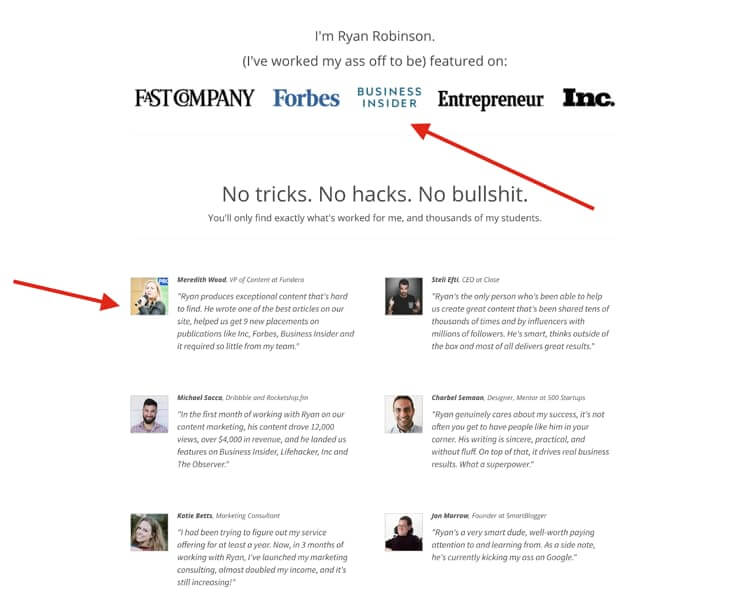

You can start incorporating social proof into your blog by prominently featuring the logos and positive testimonials of people you’ve previously worked with on your homepage or showcasing the number of subscribers your blog or email list has.
31. Take advantage of chatbots


Chatbots are quickly becoming the next secret weapon for how to grow a blog.
While most people tend to view chatbots as nothing more than customer support tools, it turns out that chatbots, call center software, and live chat solutions can do so much more when in the hands of the creatively inclined—assuming you’ve used one of the best website builders (like WordPress) that can accommodate these tools.
Imagine being able to personally greet and welcome every member of your audience as soon as they visit your website or being able to set up meetings and drive people further down your sales funnel completely automatically.
Just take a look at how Acquire uses its own chatbot tool to engage visitors. Their AI chatbot starts the conversation with “👋 Welcome to Acquire! What brings you to our site?” You can talk to different teams at Acquire by simply choosing the option. When you return to the platform, you can continue your chat where you left off. The chatbot also shows resources that might be useful to you.
Be sure to check out all of my top picks for the best AI writing tools and a primer on what AI copywriting is, to see if you should be using AI in your blogging efforts too. My tool suite, RightBlogger, may just be perfect for you.
32. Make your blog’s email newsletter shine


First things first—if you want to grow your blog and email list, you need to give your new subscribers a strong reason to stay. The key to that is crafting a killer email newsletter.
Don’t just treat your email newsletter as another way to notify your audience about your latest blog post because it can be so much more than that. A well-done email newsletter provides your audience with the latest news, updates, and content from your blog and allows you to connect with your target audience in a highly personal and engaging manner.
Give people a reason to be excited every time they find an email from you sitting in their inbox.
33. Place lead magnets everywhere


It’s hard to find a more tried-and-true method of gathering email subscribers to grow a blog, than lead magnets.
In case you’re unfamiliar with the term, a lead magnet is a special piece of content that can only be accessed once someone has given you their email address. Through using lead magnets, you can quickly grow a blog email list with loyal readers and potential customers.
The most effective lead magnets always solve a real problem experienced by the reader, clearly demonstrate the expertise and value of its creator, and promise an actionable solution. As long as you hit these three things, your lead magnet can be anything from writing an eBook to offering a pre-recorded webinar.
Once you have your lead magnet, it’s just a matter of getting it clearly placed in front of your readership. You can do this by promoting your lead magnet on your blog through pop-ups, banner ads, text placements and visual callouts in relevant posts, and regularly sharing it over on your social media channels.
34. Offer hyper-relevant content upgrades


Anytime you have a popular piece of content that’s generating a lot of traffic, you have a prime opportunity for a content upgrade.
Simply put, a content upgrade is when you strategically place a lead magnet into the middle of a relevant blog post. While simple, this is an insanely powerful tactic that saw blogger Brian Dean boost his conversion rates by 785% in just one day.
Content upgrades are highly effective as a way to grow a blog because you’re offering your readers something that you know they want.
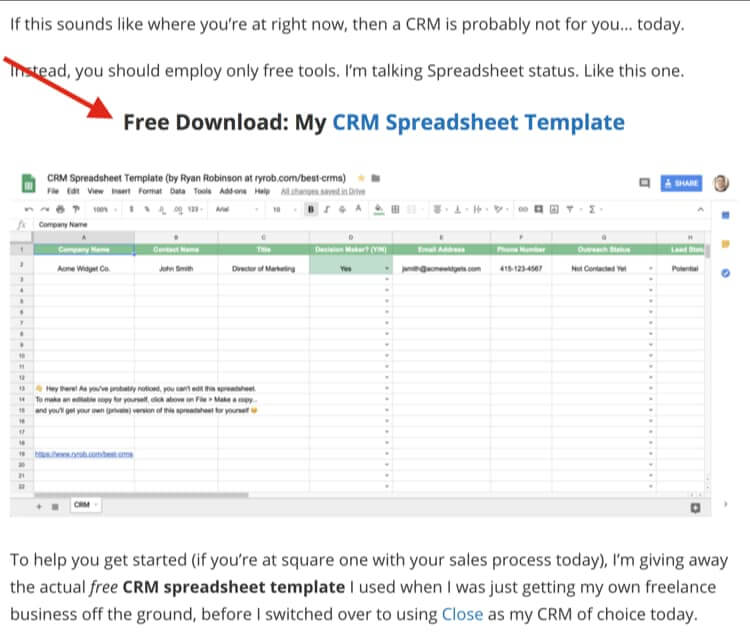

For example, in my article about the best CRMs to use, I offer my CRM Spreadsheet Template because I already know that if someone’s reading that article, chances are, they’ll be interested in using my spreadsheet template as well.
35. Target exiting readers on your blog
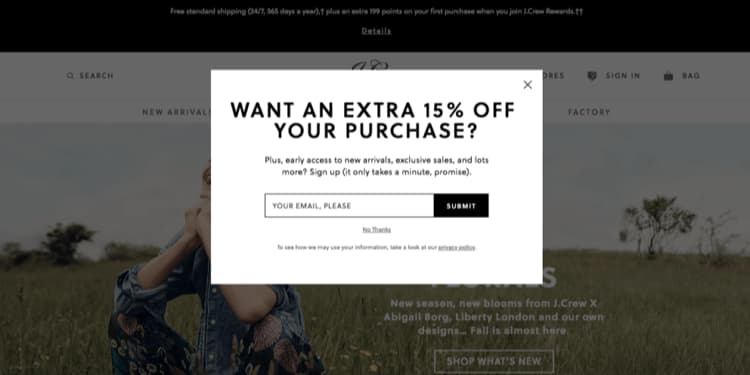

Depending on who you talk to, exit-intent pop-ups are either the most annoying thing in the world or one of the best tactics for generating more conversions to help grow a blog on autopilot.
Where you land on the side of the debate is completely up to you—all I’m here to tell you is that in my experience, I’ve seen multiple blogs and businesses use exit-intent pop-ups to great effect. Though there’s reason to believe that exit-intent popups may soon be discouraged by search engines like Google.
At the end of the day, most people who visit your blog will probably do so for a minute or two and take a quick look around before leaving it—probably forever. But just because someone is halfway out the door doesn’t mean you don’t have one last shot to turn them into a loyal fan.
You can see this in action whenever you visit the Foundr blog. Anytime a new visitor attempts to leave a Foundr page, they’ll be presented with a pop-up that presents them with a compelling lead magnet.
Exit-intent pop-ups activate whenever a visitor does a very specific action such as moving their cursor to close the browser window, open or close a tab or into the address bar. Whenever a visitor performs any one of those actions the exit-intent pop-up is triggered and the visitor is presented with a carefully crafted pop-up designed to give them one last compelling reason to stick around.
36. Create an online quiz


Take a page of out of Buzzfeed’s playbook and start creating your own online quizzes to generate new leads and grow your blog’s email list.
Something that many bloggers are just now starting to realize is that creating an online quiz—and other types of interactive content—are natural lead magnets.
The reason why online quizzes (especially Facebook quizzes) are so appealing as a lead magnet to grow a blog is that everyone has a natural desire to learn more about themselves and is usually more than happy to share their result with others—which, in turn, attracts even more people to take your quiz. In other words, quizzes are a lead-generating machine.
All you have to do to take advantage of online quizzes is to use a tool like Interact Quiz Builder, and you can immediately start creating the perfect lead-generating quiz for your blog. Once you have your quiz, it’s just a matter of promoting it through the right channels, such as through social media or just featuring it prominently on your homepage.
One extremely valuable lesson I’ve learned in my time as a blogger is that if your blog isn’t growing, then it’s dying.
Growing a blog isn’t a one-and-done kind of process. It’s something that requires constant maintenance and upkeep if you want to continue growing and achieve bigger and better blogging goals.
The good news is that you don’t have to start all the way back from square one to continue growing your blog.
You’ve already done the majority of the hard work, and all you have to do now are a few simple things to keep on maintaining that momentum you’ve built up for yourself.
37. Know your analytics data like the back of your hand


If you can’t measure it, you can’t improve it. This truth is no more clear than when it comes to learning how to grow a blog and drive more traffic.
An essential part of growing a blog is knowing exactly which metrics to measure and what data sets you should analyze. Without a working knowledge of the numbers that drive your blog, you won’t be able to spot opportunities to further improve and optimize, let alone understand how to grow a blog in the first place.
If you’re running your blog on WordPress, I highly recommend checking out MonsterInsights to help you decode and fully understand your blog’s analytics. All you have to do is link it to your Google Analytics account, and you can immediately start tracking how long people are staying on your site, what your most popular blog posts are, and much more valuable info.
38. Never stop A/B testing on your blog


No matter how great your blog is, I can guarantee you that there will always be room for improvement.
But instead of relying on gut feelings and guesses as to what changes might bring improvements, with A/B testing, you can get hard data on whether you’re achieving the best possible results to help grow your blog in the long run.
A/B testing (sometimes known as split testing) is a process that involves creating two variations of the same thing and analyzing which one produces the better results. You can A/B test virtually anything about your blog, from the best times to post, the copy of a call-to-action, to writing a headline for your latest blog post.
It’s important to treat A/B testing as an iterative process, where the key to success isn’t through making one huge change, but rather, in making several small adjustments over time. With rigorous, consistent A/B testing, you can continuously optimize and refine your overall blog strategy to ensure constant growth.
39. Automate & outsource with tools and contractors


The great thing about running a successful blog is that most of the tasks involved in maintaining its growth can easily be automated once you’ve built a certain amount of momentum.
With the right tools in place, you can take a step back from the day-to-day management and focus on the long-term growth strategy to grow your blog.
And if you’re also hosting a podcast to supercharge your blog growth, you can turn episodes into blog posts. This service does it for you so you can focus on other things.
Make sure to check out my list of 101 different tools and resources that any business can use to help you automate the running of your blog.
40. Continually experiment


Finally, and perhaps most importantly—never be afraid to experiment with new ideas and processes that could help you better learn how to grow a blog. You might be surprised by the results of a wacky experiment.
The great thing about content marketing is that it’s a constantly-changing landscape, and the ones that manage to stay at the top of their industry are always those that are willing to experiment with new strategies and tactics.
When I first started this blog, it was a way to generate some side income and spread the word about my services as a content marketing consultant.
Never in my life did I think that I would eventually expand my blog into a successful podcast or lead me to create my own free course about blogging.
All of these things started off as experiments—as small projects that eventually grew into what they are today.
How will you grow your blog this year?
I hope that you’ve gotten a lot out of this guide about how to grow a blog—and that it sparked a few ideas for new strategies you can try.
Now that I’ve broken down 40 of my favorite tactics for how to grow a blog, I know I couldn’t cover everything here today…
So, what’d I miss?
What are your favorite ways you’ve used to grow a blog?
Share with us in the comments below!
Publisher: Source link

